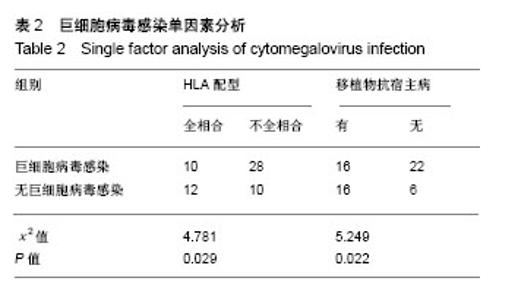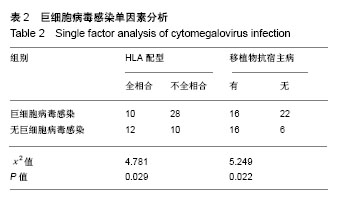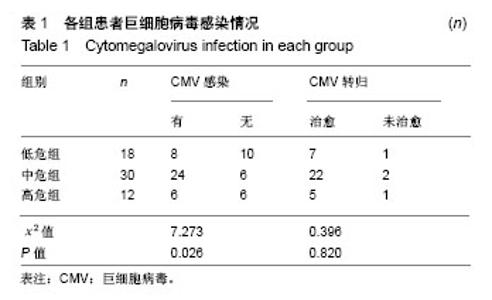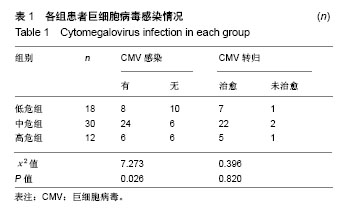Chinese Journal of Tissue Engineering Research ›› 2019, Vol. 23 ›› Issue (5): 756-760.doi: 10.3969/j.issn.2095-4344.1561
Previous Articles Next Articles
Stratification therapy for cytomegalovirus infection after allogeneic hematopoietic stem cell transplantation
Xue Hui, Feng Shuqing, Hu Yongchao, Liu Zhibin, Li Xiaoyu, Gao Feng
- North China University of Science and Technology Affiliated Hospital, Tangshan 063000, Hebei Province, China
-
Revised:2018-10-30Online:2019-02-18Published:2019-02-18 -
Contact:Gao Feng, Chief physician, Associate professor, North China University of Science and Technology Affiliated Hospital, Tangshan 063000, Hebei Province, China -
About author:Xue Hui, Master, Attending physician, North China University of Science and Technology Affiliated Hospital, Tangshan 063000, Hebei Province, China -
Supported by:Hebei Provincial Medical Science Research Project, No. 20180758 (to XH)
CLC Number:
Cite this article
Xue Hui, Feng Shuqing, Hu Yongchao, Liu Zhibin, Li Xiaoyu, Gao Feng. Stratification therapy for cytomegalovirus infection after allogeneic hematopoietic stem cell transplantation[J]. Chinese Journal of Tissue Engineering Research, 2019, 23(5): 756-760.
share this article
Add to citation manager EndNote|Reference Manager|ProCite|BibTeX|RefWorks

低危组18例中,8例患者发生CMV感染,发生率为44.4%(8/18),发生中位时间为移植后53(31-79) d。2例患者CMV-DNA<104 copies/mL,1例患者CMV-DNA> 104 copies/mL出现1次,未予干预,均于一两周后转阴;除1例合并多重感染死亡外,余经抗病毒治疗均治愈,转阴率为87.5%(7/8)。 中危组30例中,24例患者发生CMV感染,发生率为80.0%(24/30),发生中位时间为移植后40(14-83) d。7例患者CMV-DNA在102-103 copies/mL之间,未予干预,均于1-3周后转阴;上述方案抗病毒治疗后转阴率为91.7%(22/24)。 高危组12例中,6例患者发生CMV感染,发生率为50.0%(6/12),发生中位时间为移植后38(18-109) d,当出现CMV血症时,立即启动抗病毒治疗,治疗后转阴率为83.3%(5/6)。 各组CMV感染率差异有显著性意义(P < 0.05);各组CMV感染转阴率差异无显著性意义(P > 0.05)。 2.3 CMV感染单因素分析 单因素分析显示,移植后CMV感染的发生与HLA配型及移植物抗宿主病的发生有明显相关性;HLA不全相合或移植物抗宿主病的发生可能增加了CMV感染的风险,见表2。"

| [1] Goldstein G, Rutenberg TF, Mendelovich SL, et al. The role of immunoglobulin prophylaxis for prevention of cytomegalovirus infection in pediatric hematopoietic stem cell transplantation recipients. Pediatr Blood Cancer. 2017;64(7):e26420.[2] Rustia E, Violago L, Jin Z, et al. Risk Factors and Utility of a Risk-Based Algorithm for Monitoring Cytomegalovirus, Epstein-Barr Virus, and Adenovirus Infections in Pediatric Recipients after Allogeneic Hematopoietic Cell Transplantation. Biol Blood Marrow Transplant. 2016;22(9): 1646-1653.[3] Borchers S, Luther S, Lips U, et al. Tetramer monitoring to assess risk factors for recurrent cytomegalovirus reactivation and reconstitution of antiviral immunity post allogeneic hematopoietic stem cell transplantation. Transpl Infect Dis. 2011;13(3):222-236.[4] Robin C, Hémery F, Dindorf C, et al. Economic burden of preemptive treatment of CMV infection after allogeneic stem cell transplantation: a retrospective study of 208 consecutive patients. BMC Infect Dis. 2017;17(1):747.[5] 曹伟杰,万鼎铭,李丽,等.异基因造血干细胞移植后巨细胞病毒感染和抢先治疗临床研究[J].中国实验血液学杂志, 2016,24(4): 1143-1148. [6] 卢岳,吴彤,曹星玉,等.抢先治疗减少异基因造血干细胞移植后早期巨细胞病毒疾病的临床研究[J].临床血液学杂志, 2011,24(11): 655-661.[7] 李乐,王昱,闫晨.等.异基因造血干细胞移植后低载量巨细胞病毒血症抢先治疗时机的临床研究[J].中华内科杂志, 2018,57(3): 191-195.[8] 王晓宁,张梅,贺鹏程,等.异基因造血干细胞移植中巨细胞病毒潜伏感染的防治[J].临床血液学杂志,2013,26(5):298-304.[9] Camargo JF, Kimble E, Rosa R, et al. Impact of Cytomegalovirus Viral Load on Probability of Spontaneous Clearance and Response to Preemptive Therapy in Allogeneic Stem Cell Transplantation Recipients. Biol Blood Marrow Transplant. 2018;24(4):806-814.[10] 吴亚妹,曹永彬,李晓红,等.膦甲酸钠预防及抢先治疗造血干细胞移植中巨细胞病毒感染的临床研究[J]. 白血病•淋巴瘤, 2017, 26(6):331-335.[11] El Chaer F, Shah DP, Chemaly RF. How I treat resistant cytomegalovirus infection in hematopoietic cell transplantation recipients. Blood. 2016;128(23):2624-2636. [12] Razonable RR. Role of letermovir for prevention of cytomegalovirus infection after allogeneic haematopoietic stem cell transplantation. Curr Opin Infect Dis. 2018; 31(4):286-291.[13] Bowman LJ, Melaragno JI, Brennan DC. Letermovir for the management of cytomegalovirus infection. Expert Opin Investig Drugs. 2017;26(2):235-241.[14] Ong SY, Truong HT, Diong CP, et al. Use of Valacyclovir for the treatment of cytomegalovirus antigenemia after hematopoietic stem cell transplantation. BMC Hematol. 2015;15:8.[15] Gary R, Aigner M, Moi S, et al. Clinical-grade generation of peptide-stimulated CMV/EBV-specific T cells from G-CSF mobilized stem cell grafts. J Transl Med. 2018;16(1):124.[16] La Rosa C, Longmate J, Martinez J, et al. MVA vaccine encoding CMV antigens safely induces durable expansion of CMV-specific T cells in healthy adults. Blood. 2017;129(1): 114-125.[17] Yong MK, Cameron PU, Slavin M, et al. Identifying Cytomegalovirus Complications Using the Quantiferon-CMV Assay After Allogeneic Hematopoietic Stem Cell Transplantation. J Infect Dis. 2017;215(11):1684-1694.[18] Schaenman JM, Shashidhar S, Rhee C, et al. Early CMV viremia is associated with impaired viral control following nonmyeloablative hematopoietic cell transplantation with a total lymphoid irradiation and antithymocyte globulin preparative regimen. Biol Blood Marrow Transplant. 2011; 17(5):693-702.[19] 邹秉含,张钦,许亚茹,等.异基因造血干细胞移植后人巨细胞病毒感染的危险因素分析[J].中国实验血液学杂志, 2016,24(2): 551-555.[20] Valadkhani B, Kargar M, Ashouri A, et al.The risk factors for cytomegalovirus reactivation following stem cell transplantation. J Res Pharm Pract. 2016;5(1):63-69.[21] Janeczko M, Mielcarek M, Rybka B, et al. Immune recovery and the risk of CMV/ EBV reactivation in children post allogeneic haematopoietic stem cell transplantation. Cent Eur J Immunol. 2016;41(3):287-296.[22] Vaezi M, Kasaeian A, Souri M, et al. How Do Donor-Recipient CMV Serostatus and Post-Hematopoietic Stem Cell Transplantation CMV Reactivation Affect Outcomes in Acute Leukemia Patients. Int J Hematol Oncol Stem Cell Res. 2017; 11(3):199-208.[23] Kalra A, Williamson T, Daly A, et al. Impact of Donor and Recipient Cytomegalovirus Serostatus on Outcomes of Antithymocyte Globulin-Conditioned Hematopoietic Cell Transplantation. Biol Blood Marrow Transplant. 2016;22(9): 1654-1663.[24] Ramanathan M, Teira P, Battiwalla M, et al. Impact of early CMV reactivation in cord blood stem cell recipients in the current era. Bone Marrow Transplant. 2016;51(8):1113-1120. [25] Servais S, Dumontier N, Biard L, et al. Response to antiviral therapy in haematopoietic stem cell transplant recipients with cytomegalovirus (CMV) reactivation according to the donor CMV serological status. Clin Microbiol Infect. 2016;22(3): 289.e1-7.[26] Ogonek J, Varanasi P, Luther S, et al. Possible Impact of Cytomegalovirus-Specific CD8+ T Cells on Immune Reconstitution and Conversion to Complete Donor Chimerism after Allogeneic Stem Cell Transplantation. Biol Blood Marrow Transplant. 2017;23(7):1046-1053.[27] Hilal T, Slone S, Peterson S, et al. Cytomegalovirus reactivation is associated with a lower rate of early relapse in myeloid malignancies independent of in-vivo T cell depletion strategy. Leuk Res. 2017;57:37-44.[28] Teira P, Battiwalla M, Ramanathan M, et al. Early cytomegalovirus reactivation remains associated with increased transplant-related mortality in the current era: a CIBMTR analysis. Blood. 2016;127(20):2427-2438.[29] Bao X, Zhu Q, Xue S, et al. Cytomegalovirus induces strong antileukemic effect in acute myeloid leukemia patients following sibling HSCT without ATG-containing regimen. Am J Transl Res. 2016;8(2):653-661.[30] Yong MK, Ananda-Rajah M, Cameron PU, et al. Cytomegalovirus Reactivation Is Associated with Increased Risk of Late-Onset Invasive Fungal Disease after Allogeneic Hematopoietic Stem Cell Transplantation: A Multicenter Study in the Current Era of Viral Load Monitoring. Biol Blood Marrow Transplant. 2017;23(11):1961-1967. |
| [1] | Zhang Tongtong, Wang Zhonghua, Wen Jie, Song Yuxin, Liu Lin. Application of three-dimensional printing model in surgical resection and reconstruction of cervical tumor [J]. Chinese Journal of Tissue Engineering Research, 2021, 25(9): 1335-1339. |
| [2] | Zeng Yanhua, Hao Yanlei. In vitro culture and purification of Schwann cells: a systematic review [J]. Chinese Journal of Tissue Engineering Research, 2021, 25(7): 1135-1141. |
| [3] | Xu Dongzi, Zhang Ting, Ouyang Zhaolian. The global competitive situation of cardiac tissue engineering based on patent analysis [J]. Chinese Journal of Tissue Engineering Research, 2021, 25(5): 807-812. |
| [4] | Wu Zijian, Hu Zhaoduan, Xie Youqiong, Wang Feng, Li Jia, Li Bocun, Cai Guowei, Peng Rui. Three-dimensional printing technology and bone tissue engineering research: literature metrology and visual analysis of research hotspots [J]. Chinese Journal of Tissue Engineering Research, 2021, 25(4): 564-569. |
| [5] | Chang Wenliao, Zhao Jie, Sun Xiaoliang, Wang Kun, Wu Guofeng, Zhou Jian, Li Shuxiang, Sun Han. Material selection, theoretical design and biomimetic function of artificial periosteum [J]. Chinese Journal of Tissue Engineering Research, 2021, 25(4): 600-606. |
| [6] | Liu Fei, Cui Yutao, Liu He. Advantages and problems of local antibiotic delivery system in the treatment of osteomyelitis [J]. Chinese Journal of Tissue Engineering Research, 2021, 25(4): 614-620. |
| [7] | Li Xiaozhuang, Duan Hao, Wang Weizhou, Tang Zhihong, Wang Yanghao, He Fei. Application of bone tissue engineering materials in the treatment of bone defect diseases in vivo [J]. Chinese Journal of Tissue Engineering Research, 2021, 25(4): 626-631. |
| [8] | Zhang Zhenkun, Li Zhe, Li Ya, Wang Yingying, Wang Yaping, Zhou Xinkui, Ma Shanshan, Guan Fangxia. Application of alginate based hydrogels/dressings in wound healing: sustained, dynamic and sequential release [J]. Chinese Journal of Tissue Engineering Research, 2021, 25(4): 638-643. |
| [9] | Chen Jiana, Qiu Yanling, Nie Minhai, Liu Xuqian. Tissue engineering scaffolds in repairing oral and maxillofacial soft tissue defects [J]. Chinese Journal of Tissue Engineering Research, 2021, 25(4): 644-650. |
| [10] | Xing Hao, Zhang Yonghong, Wang Dong. Advantages and disadvantages of repairing large-segment bone defect [J]. Chinese Journal of Tissue Engineering Research, 2021, 25(3): 426-430. |
| [11] | Chen Siqi, Xian Debin, Xu Rongsheng, Qin Zhongjie, Zhang Lei, Xia Delin. Effects of bone marrow mesenchymal stem cells and human umbilical vein endothelial cells combined with hydroxyapatite-tricalcium phosphate scaffolds on early angiogenesis in skull defect repair in rats [J]. Chinese Journal of Tissue Engineering Research, 2021, 25(22): 3458-3465. |
| [12] | Wang Hao, Chen Mingxue, Li Junkang, Luo Xujiang, Peng Liqing, Li Huo, Huang Bo, Tian Guangzhao, Liu Shuyun, Sui Xiang, Huang Jingxiang, Guo Quanyi, Lu Xiaobo. Decellularized porcine skin matrix for tissue-engineered meniscus scaffold [J]. Chinese Journal of Tissue Engineering Research, 2021, 25(22): 3473-3478. |
| [13] | Mo Jianling, He Shaoru, Feng Bowen, Jian Minqiao, Zhang Xiaohui, Liu Caisheng, Liang Yijing, Liu Yumei, Chen Liang, Zhou Haiyu, Liu Yanhui. Forming prevascularized cell sheets and the expression of angiogenesis-related factors [J]. Chinese Journal of Tissue Engineering Research, 2021, 25(22): 3479-3486. |
| [14] | Liu Chang, Li Datong, Liu Yuan, Kong Lingbo, Guo Rui, Yang Lixue, Hao Dingjun, He Baorong. Poor efficacy after vertebral augmentation surgery of acute symptomatic thoracolumbar osteoporotic compression fracture: relationship with bone cement, bone mineral density, and adjacent fractures [J]. Chinese Journal of Tissue Engineering Research, 2021, 25(22): 3510-3516. |
| [15] | Liu Liyong, Zhou Lei. Research and development status and development trend of hydrogel in tissue engineering based on patent information [J]. Chinese Journal of Tissue Engineering Research, 2021, 25(22): 3527-3533. |
| Viewed | ||||||
|
Full text |
|
|||||
|
Abstract |
|
|||||

